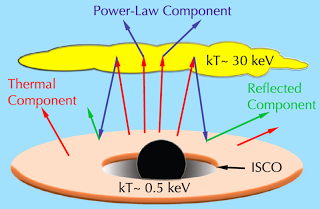Carnival of Space 226 is up at Dear Astronomer
A group led by Jerome Orosz of San Diego State University used data from optical and ultraviolet telescopes to determine the orbital velocity of the blue star around its black hole companion. From this, and knowing the distance, the astronomers found the star to be 19 times the mass of the sun and the black hole to be 15 times the mass of the sun.
Having measured both the mass and the radius, the scientists determined the black hole to be rapidly spinning and thus complete the physical description of Cygnus X-1, 47 years after its discovery with an X-ray detector onboard a rocket, and 39 years after it was determined to be a candidate for this mysterious thing called a “black hole.”
The scientific papers don’t make a big deal out of the value of the radius, or physical size, of the black hole. Though it is typical for a black hole, it is still a bit mind-blowing that almost 15 times the mass of the sun can be compacted into something 44 kilometers, or 27 miles, across. That’s just the size of an asteroid
Schematic of the black hole and its accretion disk, from Gou et al. The ISCO is the innermost stable circular orbit and goes up to the edge of the gray ellipse that represents the edge of a Kerr black hole. “kT” refers to the energy of the X-ray photons emitted from either the disk or surrounding stellar material.
From Nextbigfuture –
Space Based Solar Power Status
Japan is currently the only country with a focused solar power satellite plan. In fact, space power is one of the nine official goals of the Japanese space programme. The country’s space agency is planning to construct a solar power station in space and use it to beam energy down to earth using lasers by 2030. Other countries and startups Solaren, and Orbital power group are also working towards space based solar power.
Stellar engines are a class of hypothetical megastructures which use a star’s radiation to create usable energy. Some variants use this energy to produce thrust, and thus accelerate a star, and anything orbiting it, in a given direction. The creation of such a system would make its builders a Type-II civilization on the Kardashev scale. They are simple and technically feasible but likely impractical approaches to stellar engineering to move stars.
Image from Steve Bowers. Moving stars using light pressure. The mass of the statite reflector attracts the star like a gravity tug, causing the star and statite to slowly move
If you liked this article, please give it a quick review on ycombinator or StumbleUpon. Thanks

Brian Wang is a Futurist Thought Leader and a popular Science blogger with 1 million readers per month. His blog Nextbigfuture.com is ranked #1 Science News Blog. It covers many disruptive technology and trends including Space, Robotics, Artificial Intelligence, Medicine, Anti-aging Biotechnology, and Nanotechnology.
Known for identifying cutting edge technologies, he is currently a Co-Founder of a startup and fundraiser for high potential early-stage companies. He is the Head of Research for Allocations for deep technology investments and an Angel Investor at Space Angels.
A frequent speaker at corporations, he has been a TEDx speaker, a Singularity University speaker and guest at numerous interviews for radio and podcasts. He is open to public speaking and advising engagements.





